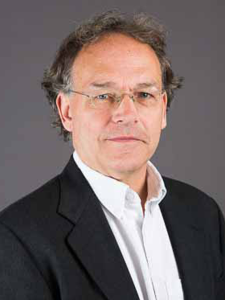Presented By: Department of Linguistics
Linguistics Colloquium
T. Daniel Seely, Eastern Michigan University

T. Daniel Seely is a Professor of Linguistics at Eastern Michigan University.
Join us in person in East Hall room 4448 or virtually on Zoom.
TITLE
On the History and Current Form of Merge
ABSTRACT
This discussion explores the history, form, and function of the most fundamental operation of the narrow syntax, Merge. The question we'll focus on is this: What 'should' Merge do, what 'should' Merge not do; and, most importantly, why?
By way of background, we give a brief history of structure building devices, from PS rules (graph-theoretic and linear-order-encoding) to successive stages in the development of Merge--from its introduction in Bare Phrase Structure (Chomsky 1994/95) to its formulation in Problems of Projection (Chomsky 2013, 2015, see also Epstein, Kitahara, Seely 2015, Collins and Seely to appear)) and to its recent characterization (Chomsky 2018, 2019, 2020, 2021), Epstein, Kitahara, Seely (2018, 2020, 2022).
Next, we trace the "maximize minimal merge" program (Epstein, Kitahara, and Seely 2018, 2022): The idea is to maximize the effects of Merge while minimizing its form, positing internal to the narrow syntax as little as possible beyond simplest Merge, striving ultimately for the thesis “3rd Factor + Interfaces + Recursion = Language,” as initially articulated in Chomsky 2007.
With this background, our primary goal is to explore Chomsky's recent thinking on Merge, from a series of lectures and papers, and ultimately trace conclusions of a forthcoming paper “Merge” by N. Chomsky, R. Berwick, S. Fong, M.A.C. Huybregts, H. Kitahara, A. McInnerney, T.D. Seely, Y. Sugimoto, in R. Freidin (ed) Elements, Cambridge.
Chomsky’s recent work suggests that what we thought was simplest Merge (unifying external and internal merge) is in fact inexplicit in crucial respects, and a revision is proposed that reconceives Merge as an operation that applies to the workspace WS, thereby allowing the monitoring of computational resources. Explored are the 3rd
factor (non-linguistic) principles that constrain Merge, its empirical consequences, challenges, and prospects for future research.
Join us in person in East Hall room 4448 or virtually on Zoom.
TITLE
On the History and Current Form of Merge
ABSTRACT
This discussion explores the history, form, and function of the most fundamental operation of the narrow syntax, Merge. The question we'll focus on is this: What 'should' Merge do, what 'should' Merge not do; and, most importantly, why?
By way of background, we give a brief history of structure building devices, from PS rules (graph-theoretic and linear-order-encoding) to successive stages in the development of Merge--from its introduction in Bare Phrase Structure (Chomsky 1994/95) to its formulation in Problems of Projection (Chomsky 2013, 2015, see also Epstein, Kitahara, Seely 2015, Collins and Seely to appear)) and to its recent characterization (Chomsky 2018, 2019, 2020, 2021), Epstein, Kitahara, Seely (2018, 2020, 2022).
Next, we trace the "maximize minimal merge" program (Epstein, Kitahara, and Seely 2018, 2022): The idea is to maximize the effects of Merge while minimizing its form, positing internal to the narrow syntax as little as possible beyond simplest Merge, striving ultimately for the thesis “3rd Factor + Interfaces + Recursion = Language,” as initially articulated in Chomsky 2007.
With this background, our primary goal is to explore Chomsky's recent thinking on Merge, from a series of lectures and papers, and ultimately trace conclusions of a forthcoming paper “Merge” by N. Chomsky, R. Berwick, S. Fong, M.A.C. Huybregts, H. Kitahara, A. McInnerney, T.D. Seely, Y. Sugimoto, in R. Freidin (ed) Elements, Cambridge.
Chomsky’s recent work suggests that what we thought was simplest Merge (unifying external and internal merge) is in fact inexplicit in crucial respects, and a revision is proposed that reconceives Merge as an operation that applies to the workspace WS, thereby allowing the monitoring of computational resources. Explored are the 3rd
factor (non-linguistic) principles that constrain Merge, its empirical consequences, challenges, and prospects for future research.